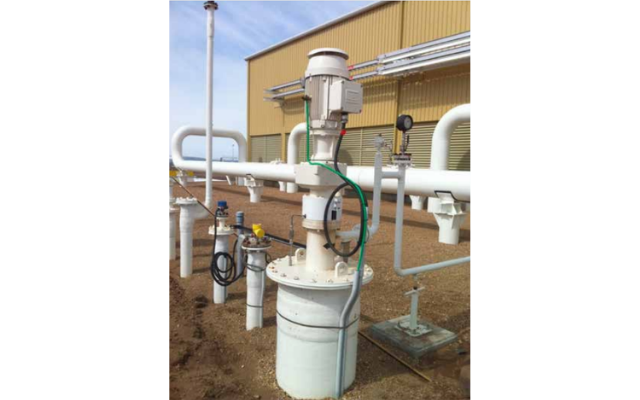When a major energy pipeline company looked to streamline their pumping system for their waste oil storage tanks, they called on NETZSCH to design and build customized vertical cavity sump pumps for lower maintenance and operational efficiencies.
For over six decades, a Canadian energy company has been in the business of delivering energy, including oil and gas across North America. A large part of the company’s business is the operation of the world’s longest crude oil and liquids transportation system, conveying crude oil and other liquid hydrocarbons from the point of supply to refining markets in the mid-western United States and eastern Canada.
Along the customer’s pipeline are pumping stations needed to power the liquid fuels through the pipeline. At each pump station, there is a 5,000-gallon (19,000-liter) underground storage tank (buried below the frost line to prevent the liquid from freezing) used as a collection point for waste oil from service work that is performed on main pipeline pumps.
As the collection tanks fill to capacity, the customer needs to pump the liquid from the tank back into the pressurized pipeline. This process had consisted of a two-pump system – with a cantilever pump used to lift the waste oil out of the tank and a high-pressure piston plunger injection pump to move the oil back into the pipeline system.
NETZSCH pump engineer Dave Hinecker, noted, “The main issue for the customer is that with two pumps for each storage tank, there is twice as much maintenance. In addition, with the high pressure required to operate the piston pump, there was a lot of pulsation that was causing pipe stress. The customer wanted to eliminate the pipe stress and simplify the system with one pump that could provide the smooth, almost pulsation free, conveyance they were looking for.”
Custom Designed NEMO® BT Series Pump Recommended
After several meetings with the customer and by understanding the process and the challenges the customer was having with their two-pump system, NETZSCH engineers designed a custom 10-stage vertical, semi-submersed, progressive cavity sump pump that would lift the heavy oil out of the tank and also have the capacity to achieve 700 psi (48 bar) of differential pressure should the system require it in an upset condition.
A number of technical issues were addressed including the use of a mechanical seal to the customer’s specifications. A common pump length with a drop tube and strainer was specified to accommodate any changes in sump depth. NETZSCH also performed chemical compatibility tests on several different elastomers. The unique selection of this pump allowed NETZSCH to eliminate any universal joints by incorporating a flexible connecting rod. NETZSCH design engineers also took into consideration the requirements of electrical service at the site and selected a 20 hp driver that corresponded with the existing two-pump electrical requirement. There were other minor design challenges such as building the stuffing box to accept the customers selected mechanical seal having the capacity to operate at 700 psi (48 bar).
The NEMO® BT pump is tailor-made for this application, with dimensions (length, mounting flange, etc.) to fit the customer’s existing underground tank. This pump is also designed to operate in reverse, requiring the seal to be on the discharge side and the entire housing to be pressurized. The rotor/stator system (pump elements) are located at the lowest point, so dry-running will be avoided. The space-saving design of the entire pump (besides the drive and discharge flange) disappears into the tank, providing for a very neat and clean installation. No additional effort needed to heat and isolate external equipment – a very important attribute in ambient operating temperatures down to -40 degrees C (-40 degrees F).
With the critical operating nature of the oil and gas transport industry, the customer has very high quality control requirements. NETZSCH NEMO® Pumps are produced in accordance with API 676 and shaft seals in accordance with API 682. Prior to placing the order, the customer also sent a team to the NETZSCH Brazil manufacturing plant to verify that the manufacturing processes would meet its high quality standards.
NETZSCH was successful in supplying 14 pumps for the customer. To date, all of the pumps are in operation with no concerns or issues from field operators. With many of these pump stations in remote locations, major benefits to the customer include less operational cost and field maintenance with only one electric motor running a single pump as well as a solution to the pipe pulsation issue. With the success of this installation, the customer has changed their current specification regarding these sump pumps to include or recommend the use of the NETZSCH NEMO® BT series pump for this application.




